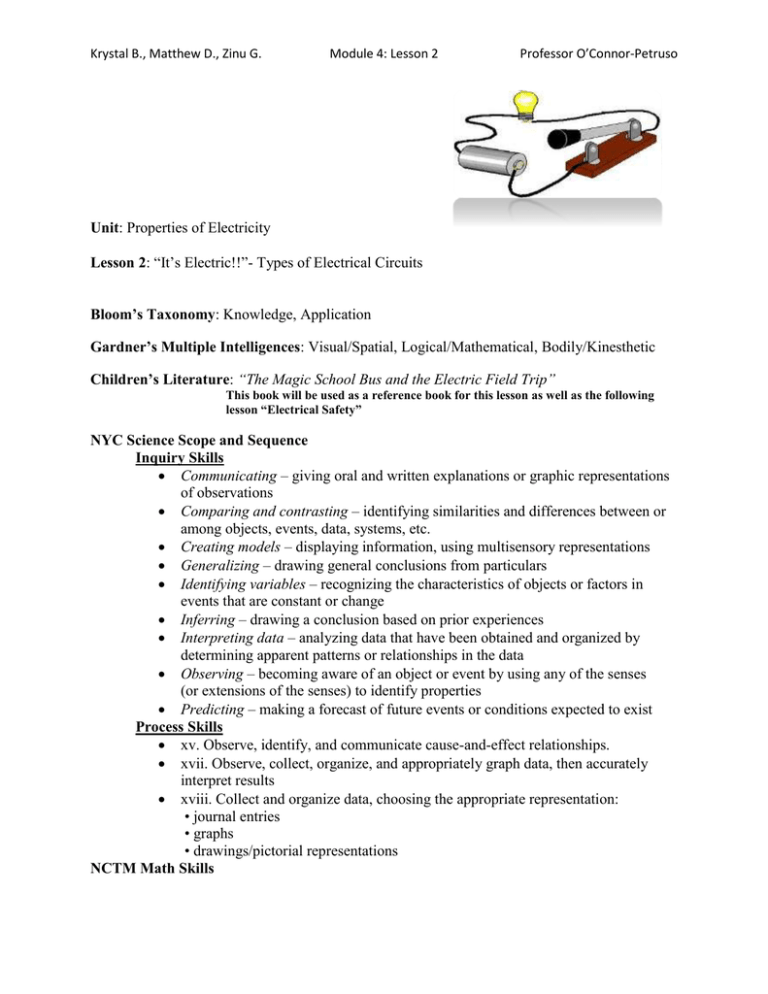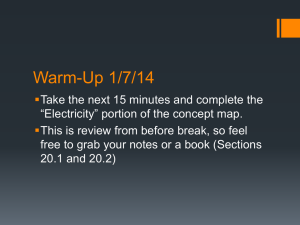3203_MST_Lesson_Plan - educ-science-math-tech
advertisement

Krystal B., Matthew D., Zinu G. Module 4: Lesson 2 Professor O’Connor-Petruso Unit: Properties of Electricity Lesson 2: “It’s Electric!!”- Types of Electrical Circuits Bloom’s Taxonomy: Knowledge, Application Gardner’s Multiple Intelligences: Visual/Spatial, Logical/Mathematical, Bodily/Kinesthetic Children’s Literature: “The Magic School Bus and the Electric Field Trip” This book will be used as a reference book for this lesson as well as the following lesson “Electrical Safety” NYC Science Scope and Sequence Inquiry Skills Communicating – giving oral and written explanations or graphic representations of observations Comparing and contrasting – identifying similarities and differences between or among objects, events, data, systems, etc. Creating models – displaying information, using multisensory representations Generalizing – drawing general conclusions from particulars Identifying variables – recognizing the characteristics of objects or factors in events that are constant or change Inferring – drawing a conclusion based on prior experiences Interpreting data – analyzing data that have been obtained and organized by determining apparent patterns or relationships in the data Observing – becoming aware of an object or event by using any of the senses (or extensions of the senses) to identify properties Predicting – making a forecast of future events or conditions expected to exist Process Skills xv. Observe, identify, and communicate cause-and-effect relationships. xvii. Observe, collect, organize, and appropriately graph data, then accurately interpret results xviii. Collect and organize data, choosing the appropriate representation: • journal entries • graphs • drawings/pictorial representations NCTM Math Skills Krystal B., Matthew D., Zinu G. Module 4: Lesson 2 Professor O’Connor-Petruso Process Standards: Students will be able to use representations to model physical, social, and mathematical phenomena Content Standards: Students will be able to develop and evaluate inferences and predictions that are based on data ISTE NETs Standards for Literate Students (1) Creativity and Innovation: Use models and simulations to explore complex systems and issues (4) Critical Thinking, problem solving, and decision making: Collect and analyze data to identify solutions and/or make sound decisions Behavioral Objectives: To be able to differentiate conductors and insulators To be able to define and identify closed circuits, open circuits, and series circuits To be able to observe and describe the transfer of energy in electrical circuits To be able to demonstrate their knowledge of electrical circuits and the transfer of energy by constructing and diagramming an electrical circuit Time Period: 2 45-minute class periods Motivational Constructivist Question (5-7minutes): Have the students stand in a circle around the classroom and asked if they have ever played the hand game “Quack Diddy-o-so?” Who can explain the game to me? (Everyone stands in a circle and arrange your hands where your right hand is on top of the hand of the person on your right and your left hand is under the hand of the person on your left. One person starts the game and the person claps the hand of the person to their left. The person whose hand is clapped at the end of the song is out). Play the game and chant/count up until 10. Play the game again and in the middle of the game, turn your body to create an open space in the circle. If one person turns their body away from the circle, can the handclaps still continue? (No, because the circle is open) So the clapping of hands can only continue if everyone is connected in the circle right? Yes. So in order for the game to continue, everyone has to be connected by hand in the circle in order for the handclaps to flow until the end of the game. The same idea applies to current and the connection it needs to flow freely in a circuit. Today we will discuss the types of circuits: closed circuit, open circuit, short circuit, series circuit, parallel circuit Procedure First Class Period 1. After the motivation, the students will take their seats. We will review what we learned in the first lesson about the properties of electricity. We will create a T-Chart to document information about the properties; in addition, we will use the T-Chart for provide a visual for the students as they respond to the differences between conductors and insulators. 2. We will introduce the term Electrical Circuit (path that allows the flow of current through wires); the students will write the definition of electrical circuit in their notebooks. 3. We will discuss new vocabulary as we identify different types of electrical circuits. As we talk about each type of circuit, we will provide a diagram on either the marker board Krystal B., Matthew D., Zinu G. Module 4: Lesson 2 Professor O’Connor-Petruso or chalkboard so the students will be able to identify what each type of circuit looks like and the transfer/non-transfer of energy that is taking place. Vocabulary: Closed circuit: circuit that has a complete path for current to flow Open Circuit: circuit that does not have a complete path for current to flow Short Circuit: low-resistance path, unintentionally made, with two bare wires in a circuit touch each other Series Circuit: circuit with the same current flowing through all components Parallel Circuit: circuit that has smaller wires with different voltage powers throughout due to the amount of resistance on the wire 4. We will transition into our children’s literature book that will focus on different types of electricity. The book is “The Magic School Bus and the Electric Field Trip.” The students will stay in their seats and we will circulate throughout the classroom so the illustrations can be seen by everyone 5. We will stop at certain points in the book to discuss what type of electrical circuit is being displayed and describe what it looks like. a. Questions to be asked i. Is Mrs. Fizzle and her class creating an open or closed circuit? ii. What does it mean when the circuit is not closed? 6. After the reading, we will have the students go back to their seats and briefly review the vocabulary as it relates to what we read in the book Second Class Period (30 minutes) 7. On the smart board, we will upload a game from www.learningcircuits.co.uk entitled “Electricity and Circuits.” Because it is an activity for the entire class to participate in, students will be selected to lead as the entire class participates. The class will be given a worksheet to complete as we the game progresses. This worksheet will be used as part of their assessment. 8. After the game is over, the students will be given an addition worksheet to complete in class in which they will label the parts of a circuit that they learned from the reading and from the game. This will count as the second part of their assessment. 9. When both worksheets are completed, they will be collected and the students will be assigned, for homework, to go online, back to this website and choose a game to play and prepare to talk about it in class the next day. Materials Marker Board with eraser “The Magic School Bus and the Electric Field Trip Smart Board Laptop with Internet Connection 30 copies of “Electricity and Circuits” Worksheets Closed-Ended Questions (minimum of two responses) What are the different types of electrical circuits we discussed? Krystal B., Matthew D., Zinu G. Module 4: Lesson 2 Professor O’Connor-Petruso Which circuit allows electricity to continue to flow even if a connection is broken? What are two ways we can make a bulb brighter in a circuit? Open Ended Questions What did you enjoy most about this lesson? How can we use what we learned about electricity today in everyday life? Assessment Student Name Parts of a Circuit (Worksheet #1) Student is able to correctly label all of the parts of a circuit 3 Student is able to identify and define most of the types of electrical circuits given Student is able to correctly label most of the parts of a circuit Constructing Types of Electrical Circuits (Worksheet #2) Student is able to construct and label diagrams of all of the types of electrical circuits given Student is able to construct and label diagrams of most of the types of electrical circuits given Identifying Types of Electrical Circuits 4 Student is able to identify and define all types of electrical circuits given Date: 2 Student is able to identify and define most of the types of electrical circuits given Student is able to correctly label some of the parts of a circuit Student is able to construct and label diagrams of some of the types of electrical circuits given SCAVENGER HUNT!!!!! Let’s find out more about electricity!!!! Use http://youtu.be/x98riv95_1E to answer the following questions 1) Will an old battery work in an electrical circuit? Why or why? 2) What happens when the battery is changed? 1 Student is unable to identify and define the types of electrical circuits given Student is unable to correctly label the parts of a circuit Student is not able to construct and label diagrams of the types of electrical circuits given Krystal B., Matthew D., Zinu G. Module 4: Lesson 2 Professor O’Connor-Petruso 3) Why is it important to turn off an electrical circuit before changing the battery? 4) How does an electrical circuit work? (http://www.edumedia-sciences.com/en/a409-electric-circuit ) Bibliography (n.d.). Retrieved from http://www.edumedia-sciences.com/en/a409-electric-circuit . Cole, J. (1997). The Magic School Bus and the Electric Field Trip. Scholastic Inc. Learning Circuits. (n.d.). Retrieved from www.learningcircuits.co.uk






